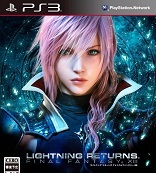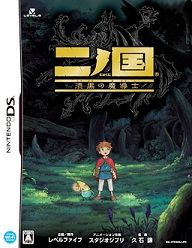Ys I and II Chronicles
PlayStation Portable
Reviewed: 2/22/2011

It is easy to stick with a series over time. A series tends to have the same quality across its titles, whether it is top-notch graphics, an excellent plot, or an enjoyable battle system. The Ys series consistently gives a fast-paced battle system, excellent music, and fantastic boss fights. Ys I & II Chronicles firmly follows this level of quality.
Music is the biggest part of experiencing Chronicles. As nice as the opening cutscenes are, the quality of music in these two games is simply astounding. There are no bad tracks in Chronicles. Each track was enjoyable to listen to or just flat out rocked. During battles the music pushes the player further into the experience, and is an engrossing part of dungeon exploration. There were times when the PSP would be left simply on to hear some of the tunes, and often the game had a player-accompanied hum. “To Make an End of Battle” and “Palace of Destruction” seem to be the essential Ys tunes, but “Holders of Power’, “Termination”, and “Battle Ground” all are great tracks. The town music even had its own charm. Even better, at the start of each game the choice between two soundtracks is available for the player; the more recent Chronicles tracks, or the earlier Complete soundtrack. The sound effects are adequate, though easily overshadowed by the stellar soundtrack.
The battle system in Chronicles may, at first, seem a bit like a glaring annoyance, but quickly becomes an asset to the game. Adol can haul some ass through the land of Esteria, and is often able to cross dungeons and screens very quickly. This comes in handy since Chronicles’ attack method is tackling the enemy with Adol’s body.
I’ma gonna let that sink in.
There’s no jumping in Chronicles or fancy dash/GTFO buttons like Oath and Seven have. Adol slams into enemies from different directions with varying results. The hit boxes of each enemy are a little different, though bringing up the rear is a solid tactic. Enemies with swords are unable to be tackled where the sword is located lest the player take damage, and enemies with shields may take less-to-no damage where the shield is located. Tackling an enemy won’t change Adol’s sprite much, but slash effects mimic the swinging of the sword and the enemies literally explode into satisfying chunks when they die. With no attack button to push, this leads to a very simple, effective, and fast-paced battle system.



A problem with the tackle system is most enemies can be taken out by approaching them from an angle and cornering them against a wall. The enemy will not be able to fight back and the player can rack up some easy kills, cash, and XP this way. Ideally, the environment would prevent the player from such easy kills, but at Adol’s speed it becomes easy to outmaneuver most foes. This does grant one great bonus of the tackle system – enemies of no consequence can be plowed through with reckless abandon. Such enemies will be few and far, however. The enemy HP and damage output tends to be pretty high, even when Adol is maxed out, and these factors help to balance out the easy kills.
Of course, the battle system gets thrown to the wind a bit when the bosses arrive. In Ys I, boss fights are pattern memorization and reflexive combat, outside of the final boss, who is a big jerk. Ys II switches this formula with the introduction of magic. Most bosses are only susceptible to the Fire spell Adol receives early in the game. The fights play out a little like space shooters, in which Adol dodges the boss and their bullet patterns while looking for the right time to strike a specific weakpoint. The last two bosses throw a little more confusion into the fray, as those fights function more like boss fights from Ys I. The boss fights are something to behold, but the final boss if Ys I is the hardest and most epic fight in the game. The formula of Ys II’s major battles is the only thing capable of preventing stagnation in the fights. It’s just a tough fight to top.
Adol levels up in the traditional fashion. Levels are not carried over between games, which is odd because the level cap in Ys I is 10 and the cap is 50+ in Ys II. Trekking across Esteria and Ys will net several items to help Adol explore the land and combat enemies. In the first game, the items to explore the land tend to be useful throughout the game while the items to help in combat are useless. For instance, the rings in the game which cut damage in half or double attack power can’t be used in boss fights, and may not work against certain enemies. On the other hand, the Mask of Eyes is found early in the game and used a few more times through Ys I. This switches in Ys II, where the magic is excellent and the items for exploration are essentially one-shot uses.
Items and levels are not the only jarring changes in Chronicles. Ys I can be completed in a scant few hours if the player is aware of how to handle the game. Ys II is easily three times longer. This does not make Ys II a time-consuming epic by any stretch of the imagination, but it is certainly a more complete experience when the two are viewed as individual titles, as the game presents.
How to handle Chronicles may seem like an odd choice of words, but it is accurate. While many things about Ys I & II have seen updates since these titles initial releases around 25 years ago, Ys I is still just as vague on its execution as the first Legend of Zelda title. Ys II handles where to go much better, but often runs into dead ends. The player needs to talk to everyone, explore everything in their surroundings, and listen to the vague hints the NPCs give you. Any additional length to Ys I is mostly attributed to aimlessly wandering around.
Exploration is the most important aspect of Chronicles. Even the smallest dungeons are mazes. There are not a lot of different locations between the two games, but the locations are full of twists, turns, and no automap.



There is nothing special regarding the story told in Chronicles. Adol washes up on a shore in Esteria and nursed back to health by the friendly locals. An avid adventurer, Adol runs around rescuing damsels and swatting demons. When Ys II begins, Adol is lying unconscious in a field and is nursed back to health by the friendly locals. He then runs around rescuing damsels and swatting demons – with fire. For the most part, this is an apt description of most Ys games.
The story in Chronicles is told through interaction with NPCs. The NPCs talk to Adol, and Adol may give a response, but for the most part plays the silent hero. The story mostly serves to break up the levels or give hints to the next location. Story parts tend to be over quickly, as the focus of Chronicles leans more to exploration and action than plot.
This is where the characterization and locations comes in. Adol has no actual dialogue in the game, just a description of what he is saying and enough interpretation that the reader may take it as they will. The other characters around Esteria and Ys bring nothing special to the RPG genre, but are likable and do not grate on the player’s nerves. The game is too short to spend any length of time with the NPCs, though Feena and Lillia attempt to take the stage at some points. The ending of Ys II has a tiny amount of emotional weight. 20 years ago this was fantastic storytelling. Regrettably, the story shows its age, though thankfully never goes bad and has enough moments to keep the player interested.
The locations wind up stealing the show. The towns are nice and vibrant, the dungeons are suitable labyrinths, and Esteria and Ys are shown to exist. At a few points in Chronicles can the player look out over a mountain and see how the land is laid out and where they ventured before. It’s a nice touch few games accomplish; that feeling of “Wow. I was there.”
The translation is good, with no noticeable flaws. The standard practice seems to tend toward slipping in pop culture phrases, but those were thankfully limited. Chronicles has both serious and lighthearted moments, and the translation reflects these adequately.
Graphically, the game is serviceable. All of the characters are sprites against mostly sprite levels… or maybe the levels are 3D? It’s hard to tell. 3D elements are interspersed throughout the levels, at least. The appearance is akin to a SNES or GBA title, and is nothing spectacular or pushing the limits of the PSP. Several of the bosses look pretty badass, and the game flows decently. The portraits are of excellent quality, and the animated cutscenes the game contains are very good. There is a striking image associated with the first two Ys games which is a personal favorite of mine. It is one of the Goddesses of Ys standing naked, yet covered by a plot device in which magic flows. It’s a very good image; highly reminiscent of several fantasy pieces, but always manages to captivate me in its simplicity.
The game has longer load times than its previously released sequels, but well within tolerance. For the most part, the game plays exceptionally well, though a handful of instances caused the game to slow down or skip.
The game has lots of little, unimportant things to do, like light villagers on fire or get borders for the screen. Upon beating the game, the Time Attack/Boss Rush mode is unlocked, allowing players to try and beat their previous times against bosses. Beating the mode does little for the player, but is a welcome addition.
Chronicles has little replay value. There are different difficulty levels available. However, the difficulties are only for action aficionados and not meant for the casual player. Once the main games are beaten and maybe Time Attack conquered, the game is complete. Between the lack of replay and the dated story, the lasting appeal of the game suffers.
Chronicles has everything an Ys game should: Excellent music, fast action, and great boss fights. Allow me to tell you again about the music – I cannot stop listening to it. I am listening to it as I type this. The music is that good. The rest of the game may not be up to levels of Oath or Seven, but the game is an overall decent time and a great recommendation for Ys fans. For everyone else, it’s a quick, fun game to play with a good challenge level, provided you are open to exploration.
-Russ Ritchey
| Score Breakdown | ||
| Overall Very Good Out of 10 See our Review Criteria |
Gameplay | Very Good |
| Story | Average | |
| Graphics | Good | |
| Sound/Music | Legendary | |
| Replay Value | Average | |
| The Verdict: Very Good | ||








